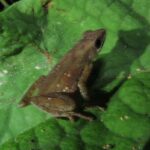- Balebreviceps hillmani: The Secretive Frog of Ethiopia's Bale Mountains
- Taxonomy and Classification
- Natural Habitat: A Jewel in the Mountains
- Enchanting Appearance: A Frog Unlike Any Other
- Mysterious Behaviors and Remarkable Life Cycle
- The Crucial Ecological Role of Balebreviceps hillmani
- Threats and Conservation Status: Living on the Brink
- Cultural and Scientific Importance
- Conclusion: Our Shared Responsibility
Balebreviceps hillmani: The Secretive Frog of Ethiopia’s Bale Mountains#
On the mist-covered slopes and moss-laden forests of Ethiopia’s spectacular Bale Mountains, a reclusive amphibian leads a concealed existence. Known as the Ethiopian Short-headed Frog, or scientifically as Balebreviceps hillmani, this frog captivates biologists and nature lovers alike through its peculiar appearance, elusive behavior, and fragile life bound intricately to one of eastern Africa’s most biodiverse mountain ecosystems. Though diminutive in size, Balebreviceps hillmani has emerged as an icon—an ambassador for Ethiopia’s unique wildlife and a driving force behind conservation efforts in these rarely explored highlands.
Hidden in the humid mossy layers beneath roots and fallen vegetation, this enigmatic amphibian confronts extraordinary challenges. Its restricted habitat, combined with ecological vulnerability and looming threats, emphasizes the importance of detailed biological study and targeted conservation actions. Let’s delve into the fascinating life of Balebreviceps hillmani and understand why this obscure little frog matters profoundly to conservationists and nature enthusiasts alike.
Taxonomy and Classification#
Balebreviceps hillmani belongs to the amphibian family Brevicipitidae, commonly referred to as rain frogs or short-headed frogs. First described scientifically by biologist Largen and his colleagues in 1998, the genus name “Balebreviceps” combines “Bale” (after Ethiopia’s Bale Mountains, its only known home) and “Breviceps,” denoting its close relation to other species within the Brevicipitidae.
This family is renowned for its unique body shapes and reproductive behaviors, and Balebreviceps hillmani is no exception. Within Brevicipitidae, its genetic distinctiveness underscores the evolutionary history of Ethiopia’s high-altitude fauna, emphasizing the region’s biological richness and endemism. Scientists regard it not only as a distinctive species but also a crucial piece of the evolutionary puzzle, providing insights into how isolated ecosystems shape biodiversity over millennia.
Natural Habitat: A Jewel in the Mountains#
A Localized Range Amid Mountain Clouds#
Nestled exclusively within the moist afro-alpine heathlands and montane forests of southern Ethiopia’s Bale Mountains National Park, Balebreviceps hillmani inhabits altitudes between 2,800 and 3,200 meters above sea level. Here, in the critical Ethiopian biodiversity hotspot, cool temperatures and perpetual mist cloak the landscape in veils of secrecy and charm.
Dominated by giant heather (Erica arborea), aromatic herbs, and richly layered mosses, the habitat of Balebreviceps hillmani feels almost mythical. The constant moisture, thick vegetation carpets, and shaded hiding spaces provide perfect conditions for these moisture-dependent creatures. To trace the frogs is to undertake a silent pilgrimage through a gauzy, shadowed wilderness that seems virtually untouched by modern development.
An Underground Dweller’s Paradise#
What most notably defines this frog’s habitat is not merely the dense vegetation, but the rich layer of damp leaf litter and humus underfoot. Beneath these mats of decomposing plant material, decaying logs, and beneath tangled vine roots, Balebreviceps hillmani excavates shallow burrows and remains mostly subterranean. Shielded from predators and temperature fluctuations, the frogs enjoy a near-perfect microclimate designed by evolution itself.
Such subterranean lifestyles allow these frogs to conserve water in their moisture-laden surroundings effectively—a strategy essential for survival within their limited mountain habitat. Its secretive underground existence, however, also makes studying the species particularly challenging.
Enchanting Appearance: A Frog Unlike Any Other#
At first glance, Balebreviceps hillmani appears somewhat un-froglike to the casual observer. Its body is squat and rounded, compactly built, with short limbs and fingers adapted especially for burrowing rather than leaping. Adults measure just about 20 to 25 millimeters in length, making them easily overlooked but remarkably well-adapted to their habitat. With skin of subtle earth tones—ranging from mottled olive-brown to reddish-brown—they seamlessly blend in with the soil and rotting vegetation around them.
Their head, as suggested by their common name, seems remarkably short and flat, almost embedded into their rounded bodies. Relatively tiny eyes peek forth from atop subtly defined ridges. While seemingly modest, this morphology represents evolutionary precision at its highest—each physical trait meticulously sculpted by eons of adaptation into perfect harmony with its surroundings.
Mysterious Behaviors and Remarkable Life Cycle#
Nocturnal Foragers of the Undergrowth#
The Ethiopian Short-headed Frog’s shy behavior also contributes to its intangible allure. Primarily nocturnal, they patiently wait beneath the forest litter before cautiously emerging after sunset to hunt small insects, termites, and soil-dwelling invertebrates. Equipped with their tiny but efficient jaws and sticky tongue, these miniature hunters quietly prowl the damp nightscape, their movements gaining confidence as darkness deepens and humidity peaks.
Fascinating Parental Care and Breeding Strategy#
Another fascinating dimension of Balebreviceps hillmani’s natural history is its reproductive strategy. Unlike many amphibians which lay eggs in water, these frogs practice an entirely terrestrial life cycle—a critical adaptation to their mountain habitat characterized by scarce standing water bodies. Females lay small clutches of eggs within burrows dug underground and diligently guard them against potential predators or fungal invasion. Remarkably, when hatched, the frogs skip an aquatic tadpole phase altogether, emerging as tiny replicas of the adult, fully terrestrial from the start.
This direct development life cycle not only reduces predation risks during vulnerable early life stages but also frees this species from dependence on permanent water, allowing it to colonize habitats inaccessible to many other amphibians—though, paradoxically, binding its fate tightly to moisture-rich habitats in other ways.
The Crucial Ecological Role of Balebreviceps hillmani#
Although small and cryptically hidden, these diminutive amphibians serve critical ecological functions within the Bale Mountains ecosystem. Feeding predominantly on small invertebrates, they help control insect populations, contributing to ecological balance. Their burrowing activity aerates the soil and facilitates nutrients cycling in the delicate mountain ecosystem, maintaining overall ecological health.
Moreover, amphibians often serve as vital bio-indicators due to their porous skin, which makes them especially sensitive to environmental changes. The fate of Balebreviceps hillmani can thus provide early signals of broader ecological degradation or climate change impacts unfolding across these remote mountain landscapes.
Threats and Conservation Status: Living on the Brink#
Classified as “Critically Endangered” according to the IUCN Red List, Balebreviceps hillmani faces significant threats to its survival. Habitat loss due to agricultural encroachment, grazing pressure from livestock, deforestation, and climate-change-induced fluctuations in rainfall and humidity patterns endanger the species’ limited habitat and delicate balance with its environment.
Conservation initiatives aimed at safeguarding the Bale Mountains’ ecological integrity constitute essential lifelines for the species’ survival. Local awareness campaigns, habitat management, and species monitoring projects are underway, highlighting the frog’s ecological and cultural significance to indigenous communities, hoping to foster active stewardship and conservation advocacy.
Cultural and Scientific Importance#
As an endemic species unique to Ethiopia, this rarely-seen frog highlights a vital aspect of Ethiopian natural heritage and ecological uniqueness. Its recent scientific discovery underscores the critical importance of continued biological exploration of the Bale Mountains, revealing the potential for additional, yet unknown, biodiversity. Furthermore, its survival has increasingly become a barometer for measuring the nation’s commitment to biodiversity and natural resource conservation.
Conclusion: Our Shared Responsibility#
Balebreviceps hillmani embodies the unseen yet essential beauty hidden within Ethiopia’s Bale Mountains ecosystem. Now threatened with extinction, every person who learns its name and story contributes to its chance of long-term survival. We possess an opportunity—and responsibility—to protect and preserve such subtle inhabitants of our planet.
Support conservation organizations, spread knowledge, and advocate for direct actions ensuring beautiful species like the Ethiopian Short-headed Frog endure for generations to come, reminding us of nature’s enduring mystery, beauty, and immense worth.







